| NOTE: Recently, a modeler of quite exceptional talent has come to our attention, and we would like to show off some of his work. So here in his own words is Steve Priske. For more indepth coverage of his work visit his website which contains literally hundreds of photos of his work. I spent a most enjoyable afternoon there.– RNP Introduction I'm in love with ship models! For the past 40 years I've spent most of my spare time at my work bench, immersed in the world of building model ships. From Clipper ships, Pirate ships to R/C speed boats, to date I have completed over 55 plank on frame ship models. A couple of my models have appeared in major motion pictures, while others can be found in restaurants, private collections and in museums. Fortunately, a few years back, I found a way to make money at my favorite hobby. Let me share with you some of my secrets for turning your modeling skills into cash. Like most meddlers, in my youth I built many plastic models, Clipper ships and World War Two battleships being my favorite. After three or four Revell kits of the infamous Cutty Sark and Thermopylae, built for family and friends, I took the plunge into a wood plank on frame model, and what a rewarding experience. 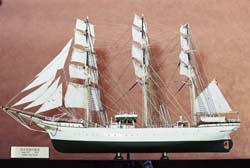 My first plank on frame model ship was the Billings kit of the Danmark. Now first, I'd like to point out that a plank on frame model 'kit', is still pretty much a scratch build affair. Except for the metal parts you get in a wood model kit you will have to build the hull, deck structures, masts and spars from scratch! Planning is paramount to completing a plank on bulkhead,model, as you cannot 'test fit' all the parts, until you build them. Therefore read over all directions and blueprints several times before starting anything. Today the Danmark sits in a bay window, overlooking Santa Barbara, California, part of a private collection. My first plank on frame model ship was the Billings kit of the Danmark. Now first, I'd like to point out that a plank on frame model 'kit', is still pretty much a scratch build affair. Except for the metal parts you get in a wood model kit you will have to build the hull, deck structures, masts and spars from scratch! Planning is paramount to completing a plank on bulkhead,model, as you cannot 'test fit' all the parts, until you build them. Therefore read over all directions and blueprints several times before starting anything. Today the Danmark sits in a bay window, overlooking Santa Barbara, California, part of a private collection. I find the internet and used book shops have a wealth of photographic information for background study. Another great source for historical inspiration are old National Geographics; Most libraries have the all important Geographic 'index' volumes that make finding the right story a breeze. I always include a brass plaque with my models, detailing some history of the ship, and something about the model. This small but important addition adds value and immortalizes you the builder. A few years back, while living in Los Angeles, I came upon a Maritime art gallery in the Marina Del Rey section of Los Angeles. I readily volunteered a model of the Danmark, I had just completed for a private party. Although there were many other fine models on display, my model attracted the attention of Hollywood movie art director Jeffrey Beecroft. Eventually he invited me to his house, to repair a model passed down in his family. As I entered his impressive home, I spotted two Academy Awards prominently displayed. Knowing he was an art director, I asked him if they were props from a movie he had worked on. Boy, did I feel foolish when he informed me they were 'genuine'’ one of which he was awarded for his art direction on the film Aliens! It turned out, Mr. Beecroft was testing me with the repair to his family heirloom, as when I returned a week later, with his repaired Newfoundland schooner, he asked me if I would be interested in building a model for a movie he was working on. Well blow me down, what do you think I said? ""You bet!" 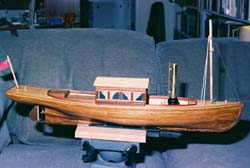 The next month was spent visiting the Warner Brothers studios where the pre-production for the eventual Academy Award movie, The Bodyguard was taking place. After lots of discussion the British director of the film, Mick Jackson had me build a, plank on frame, remote controlled model of a Thames River boat (c.1910), as these intrepid vessels were close to his heart. I was fortunate to find a kit of such a model made by Constructo. However, I would have to enlarge the plans from that kit, to accommodate the films requirements, thus scratch building the entire affair. The next month was spent visiting the Warner Brothers studios where the pre-production for the eventual Academy Award movie, The Bodyguard was taking place. After lots of discussion the British director of the film, Mick Jackson had me build a, plank on frame, remote controlled model of a Thames River boat (c.1910), as these intrepid vessels were close to his heart. I was fortunate to find a kit of such a model made by Constructo. However, I would have to enlarge the plans from that kit, to accommodate the films requirements, thus scratch building the entire affair. During the filming of the movie The Bodyguard, one of the 'prop' handlers sank the model in between takes! Being a battery powered, remote controlled boat model, all the electronics shorted out. Following a frantic phone call to me at my 'day' job, telling me it was costing them thousands of dollars for the down time, I agreed to leave work and fix the model. Nothing more was required than to replace the servos and batteries, and given my 'saving' the day, I was handsomely rewarded. Best of all, I got to feel like the most important person on a big time Hollywood movie set, well for a day! Now that I realized people would pay one to build ship models I had to find another market place. From my previous experience I realized that art galleries will double whatever you ask for a model you wish to sell through them. Not wishing to see my work over priced and never sold, I racked my brain for a better outlet. Brainstorming through the Yellow Pages, I came across the Interior Design section – ding – 'light goes off!' Next day I was in my car, photographic portfolio in hand, knocking on the door of several interior design companies. Well wouldn't you know, these folks had tons of painters, sculptors and the like in their files, but no one had a 'three dimensional' model maker available for commissions. Leaving my bio and some photos on file at a couple of interior design houses, it didn't take more than a month, and I was asked to submit a bid for a ship model that would be part of an new theme park being built on an island in Nagasaki, Japan. I knew they weren't getting any bids from competing model ship builders, so I struck a deal with them. I told them I would build this model, a Dutch Man'O'War (The Golden Lion c.1660) for half what I would usually charge for such a model, on the condition they commissioned me again in the future. They agreed. 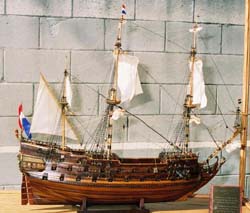 The Golden Lion took me over 1,000 hours to complete. A large 5 foot long, 1/50th scale plank on frame model, I built her based on the plans and laser cut keel in the Corel kit of the Wappen Von Hamburg. My research into Dutch war ships of the 17th Century told me they were the only country at the time able to build 'identical' ships of the line. Their mastery of windmill powered saw mills, provided Dutch ship builders with consistently cut timbers, something beyond other shipyards before the steam powered saw mill 200 years later. This being the case I could be historically accurate building the Von Hamburg kit into the Golden Lion by changing only the deck structures and stern ornamentation to suit. The Golden Lion took me over 1,000 hours to complete. A large 5 foot long, 1/50th scale plank on frame model, I built her based on the plans and laser cut keel in the Corel kit of the Wappen Von Hamburg. My research into Dutch war ships of the 17th Century told me they were the only country at the time able to build 'identical' ships of the line. Their mastery of windmill powered saw mills, provided Dutch ship builders with consistently cut timbers, something beyond other shipyards before the steam powered saw mill 200 years later. This being the case I could be historically accurate building the Von Hamburg kit into the Golden Lion by changing only the deck structures and stern ornamentation to suit. A couple years ago I got the bug to move from California to Southern Oregon, where historical records indicated many 19th Century Packets, Clipper and Windjammers had ports of call. What I didn't expect was the spectacular rugged coastline, where I've photographed all my models since moving here to Coos Bay. Not that ship models are not impressive enough on their own, but photographing them overlooking a dramatic scenic coastal lookout makes them really stand out. When photographing a ship model at the sea's edge, always do the following: 1. Have a platform to place the model on, so the hull lines up near at the horizon. 2. Even though you are outdoors, in daylight, always use a flash. 3. With your subject model centered in the frame, wait for the ocean to do something notable in the background, before snapping that dramatic photo. 4. Photograph your subject, looking up at it! Do not stand over a model or place it on the ground when photographing it. Ships are big objects, and to make a scale replica look like the real thing, get below it (hands and knees) and shoot up. I always take a 5 foot square, neutral black, felt drop cloth with me, as placed under the model, covering the platform, it helps keep unwanted reflections down to a minimum and makes for a great contrasting backdrop when needed. Today, with the advent of the internet, one no longer needs to 'knock on doors’ to find a market for museum quality ship models. Although I still work for interior design houses and will do several private commissions per year, I've found you can successfully sell museum quality ship models direct to the public at places like e-Bay. If you take many photographs of your models under construction and completed, you can give potential buyers a good idea of your model without it being there in person. I've also found many free or inexpensive online photo album web sites which you can link friends, admirers and buyers to. In 2002 I reached another milestone in ship model building, when the Era of Clipper Ships added me to their incredible web site. Although a big undertaking I try to build at least one large Clipper ship model every year. Also I try to avoid building models that are commonly available, to keep my work as unique as possible. (There are enough models in the world of the Cutty Sark and Constitution). Of all sailing ships, the sleek, speedy, Tea Clippers of the mid 1800's have captured the imagination of historians and maritime art lovers alike. Only the United Kingdom and the United States built these greyhounds of the sea. The most notable Clipper ship builder in America was Donald McKay, and it is his descendants who own and operate the Era of Clipper Ships web site. Perusing their huge web site, I was immediately intrigued by the stories of lesser known ships, many of which set records that stand to this day. One such shis was the Extreme Clipper Comet. 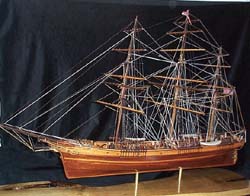 This somewhat unknown Extreme Clipper has one of the most interesting histories of any ship, ever! Built by William Webb the Comet was launched in 1851 at New York. The 241 foot long Extreme Clipper was intended primarily for the passenger and cargo trade to the newly discovered gold fields of California. Most notable of the Comet's deck layout was her quarter (poop) deck which extended 60 feet forwards to the main mast. She was a commodious ship elegantly furnished, with carpeting, sliding partitions, smoking room, toilets, bath room and a fine library. A handsome ship, the Comet was conceded to be one of the fastest sailors and most successful ships ever to sail. This somewhat unknown Extreme Clipper has one of the most interesting histories of any ship, ever! Built by William Webb the Comet was launched in 1851 at New York. The 241 foot long Extreme Clipper was intended primarily for the passenger and cargo trade to the newly discovered gold fields of California. Most notable of the Comet's deck layout was her quarter (poop) deck which extended 60 feet forwards to the main mast. She was a commodious ship elegantly furnished, with carpeting, sliding partitions, smoking room, toilets, bath room and a fine library. A handsome ship, the Comet was conceded to be one of the fastest sailors and most successful ships ever to sail. In 1853, on a return voyage from San Francisco, the Comet had an interesting race with a stable mate, the Flying Dutchman. Although often within pistol shot of each other, after rounding Cape Horn, the Comet flew ahead of her rival, arriving in New York 29 hours before the Dutchman. On another run from San Francisco, (Dec. 1853) the Comet reached New York in a passage of 76 days, the record from S.F.O. to any North Atlantic port to this day. Most Clipper ships made their record runs in the first couple years of life, while their timber and rigging were new. However, the Clipper Comet, in 1854 loaded at Liverpool for Hong Kong, and made that passage in 84 days, another record believed to stand as the fastest to this day! 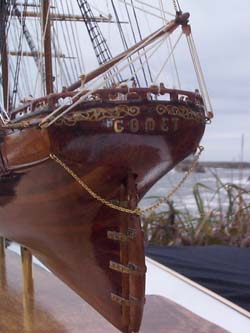 The Comet's fate is equally intriguing. By 1865 she had been sold to a British concern and renamed the Fiery Star. When three weeks out from Brisbane to London, she was discovered to be on fire. Everything was battened down and water pumped into the hold to no avail. All the passengers and part of the crew, in all some 80 persons took to the life boats, leaving the mate and 17 crew behind, there not being room in the boats for them. The plan was for the lifeboats to stay close by overnight. However, next morning the three lifeboats, were no where to be found, never to be heard from again. Just as the Comet was about to sink, the bark Dauntless, from Kingston for Auckland, happened upon the scene, and saved those who had volunteered to stay behind! The Comet's fate is equally intriguing. By 1865 she had been sold to a British concern and renamed the Fiery Star. When three weeks out from Brisbane to London, she was discovered to be on fire. Everything was battened down and water pumped into the hold to no avail. All the passengers and part of the crew, in all some 80 persons took to the life boats, leaving the mate and 17 crew behind, there not being room in the boats for them. The plan was for the lifeboats to stay close by overnight. However, next morning the three lifeboats, were no where to be found, never to be heard from again. Just as the Comet was about to sink, the bark Dauntless, from Kingston for Auckland, happened upon the scene, and saved those who had volunteered to stay behind! The model is completely scratch built, using several exotic woods, including; teak for the hull and deck planks, mahogany for the handrails, cabin trim and afterdeck house planking. The Comet's hull is plank on frame constructed, just like the full size ship (no 'cheap’ solid hulls here, as are the Teak deck planks, which were laid with 'real’ caulking between each plank! I intentionally planked a contrasting limewood plank onto the port side hull to represent the waterline. 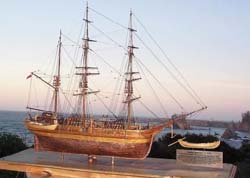 One of the most complex ship models I've ever scratch built, is a Boston Whaler, The Minnesota of New Bedford c.1850. She is a 1/50th scale model measuring over 3 1/2 feet long and of special interest are the over 700 individual copper plates attached to the hull, just as were found on the full sized ships of the era. One of the three whaling boats has been crafted into a 'half hull' model mounted in front of the main ship. The model is a double plank on frame affair, with every conceivable tool and implement used for whaling created in great detail. I wanted the half hull whaling boat at the ships waterline level, so she was mounted with a wood spacer for height. I used both sides of this wood piece, for two different historical brass plaques. It took well over 1,200 hours to complete this unique, one of kind, museum quality piece. One of the most complex ship models I've ever scratch built, is a Boston Whaler, The Minnesota of New Bedford c.1850. She is a 1/50th scale model measuring over 3 1/2 feet long and of special interest are the over 700 individual copper plates attached to the hull, just as were found on the full sized ships of the era. One of the three whaling boats has been crafted into a 'half hull' model mounted in front of the main ship. The model is a double plank on frame affair, with every conceivable tool and implement used for whaling created in great detail. I wanted the half hull whaling boat at the ships waterline level, so she was mounted with a wood spacer for height. I used both sides of this wood piece, for two different historical brass plaques. It took well over 1,200 hours to complete this unique, one of kind, museum quality piece. Here are some tips on how to build an impressive, valuable ship model. 1. Research before building. Add little touches to the model, that you pick up in your research. Signature flags, unusual deck fittings and historical figurines will set you model apart from the rest. Always include an historic brass plaque with your models. 2. Photograph your model profusely. Take photos under construction, and when completed. I often give my clients a , much lauded, photo album of some of these photos. See how to photo tips earlier in this story. 3. Most model ships come with 'cordage’ that is way too thick for the scales involved. I use 'carpet’ thread for the ratlines on the shrouds, halyards, gaskets, reefing lines and the like. Sewing thread on the other hand is too thin for most scales. 4. I use a light weight Egyptian cotton cloth for sails (in an off white color), when sails are added. Like the cordage, the cloth provided with most kits, is far too bulky for a proper scale look. If you wish to 'age’ your sails, soak them in a dark tea for a while. 5. Today I use three varieties of CA (instant) glues; thin, thick and gap filling, for model ship building. The days of slow drying wood glues are over. Use only 'thin’ super glue on the hull planks as it sands quite easily, with minimum pressure. 6. I no longer use wood fillers on my plank on frame ship models. Instead I do an initial sanding of the hull, collect the sanding dust, and mix it with 'thin' CA glue and spread it into required gaps. Once dry and sanded, it blends flawlessly with the planked hull. As you can see, building model ships can be an intriguing and rewarding experience. For me every project is an adventure and it doesn't hurt to make a little money along the way. One thing I like to point out to clients and admirers is, museum quality ship models often outlast canvas and carved artwork, making them one of the most enduring forms of nautical collectable fine art. A quick trip to your local maritime museum might reveal ship models four and five hundred years old! So, if you would enjoy a rewarding seafaring adventure and possibly some immortality, smell the salt air and build a ship model. Steve Priske – Coos Bay, Oregon – 2003 Builders Bio: I was born in the U.S. but raised in Brazil for 12 years then later Australia for 7 years. This gave me plenty of time to develop my modeling skills. At 21 I became a scuba diving instructor for the Diving Locker in San Diego, and as a result, spent a lot of time at sea (on 80 foot dive boats). My fascination with ships, led me to join the California Wreck Diving Association, with whom I've dived on many shipwrecks, including the Star of Scotland and the Valiant . In 1979, I was hired by Pan American Airlines, as an In-Flight Purser. Flying for Pan Am for ten years, I logged over 4.5 million miles (that's nine times to the moon and back), traveling to every corner of the globe. When Pan Am went out of business, I happened to be based in Los Angeles. 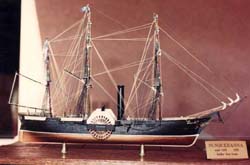 During a 'ship model' art show, in L.A., I was approached by an art director, for Kevin Costner's company, TIG productions. They commissioned me to build the model you see throughout the film, The Bodyguard. The model was so integral to the film, it was written into the script. Aside from building the boat model you see in the film the Bodyguard, I also was the technical advisor on the film HOOK (showed them how to rig the FULL sized pirate ships they built for the film). And quite a few years back, I built a model of the war ship, Susquehanna, which was used in the t.v. series Dynasty. During a 'ship model' art show, in L.A., I was approached by an art director, for Kevin Costner's company, TIG productions. They commissioned me to build the model you see throughout the film, The Bodyguard. The model was so integral to the film, it was written into the script. Aside from building the boat model you see in the film the Bodyguard, I also was the technical advisor on the film HOOK (showed them how to rig the FULL sized pirate ships they built for the film). And quite a few years back, I built a model of the war ship, Susquehanna, which was used in the t.v. series Dynasty. Two years ago, I decided to see what the scenic Oregon coastline looked like, so I moved here to Coos Bay. As you see in the many photos of my recent ship models, this is a wonderful place for photography. If you would like a link to my online photo album with hundreds of ship model photos or if you wish to discuss a commissioned model for your collection; e-mail me References: Voyagers by Herb Kawainui Kane – order direct from him at – herbkane@kona.net American Clipper Ships – Volumes 1 & 2 – Howe & Matthews – Dover Publishing BSI Adhesives – I use BSI CA glues exclusively The Bodyguard – TIG Productions – starring Kevin Costner and Whitney Houston | 









|
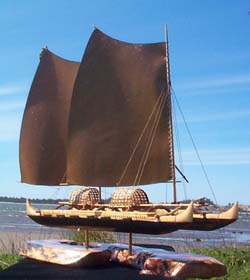 Steve Priske
Steve Priske  My first plank on frame model ship was the Billings kit of the Danmark. Now first, I'd like to point out that a plank on frame model 'kit', is still pretty much a scratch build affair. Except for the metal parts you get in a wood model kit you will have to build the hull, deck structures, masts and spars from scratch! Planning is paramount to completing a plank on bulkhead,model, as you cannot 'test fit' all the parts, until you build them. Therefore read over all directions and blueprints several times before starting anything. Today the Danmark sits in a bay window, overlooking Santa Barbara, California, part of a private collection.
My first plank on frame model ship was the Billings kit of the Danmark. Now first, I'd like to point out that a plank on frame model 'kit', is still pretty much a scratch build affair. Except for the metal parts you get in a wood model kit you will have to build the hull, deck structures, masts and spars from scratch! Planning is paramount to completing a plank on bulkhead,model, as you cannot 'test fit' all the parts, until you build them. Therefore read over all directions and blueprints several times before starting anything. Today the Danmark sits in a bay window, overlooking Santa Barbara, California, part of a private collection. The next month was spent visiting the Warner Brothers studios where the pre-production for the eventual Academy Award movie, The Bodyguard was taking place. After lots of discussion the British director of the film, Mick Jackson had me build a, plank on frame, remote controlled model of a Thames River boat (c.1910), as these intrepid vessels were close to his heart. I was fortunate to find a kit of such a model made by Constructo. However, I would have to enlarge the plans from that kit, to accommodate the films requirements, thus scratch building the entire affair.
The next month was spent visiting the Warner Brothers studios where the pre-production for the eventual Academy Award movie, The Bodyguard was taking place. After lots of discussion the British director of the film, Mick Jackson had me build a, plank on frame, remote controlled model of a Thames River boat (c.1910), as these intrepid vessels were close to his heart. I was fortunate to find a kit of such a model made by Constructo. However, I would have to enlarge the plans from that kit, to accommodate the films requirements, thus scratch building the entire affair. The Golden Lion took me over 1,000 hours to complete. A large 5 foot long, 1/50th scale plank on frame model, I built her based on the plans and laser cut keel in the Corel kit of the Wappen Von Hamburg. My research into Dutch war ships of the 17th Century told me they were the only country at the time able to build 'identical' ships of the line. Their mastery of windmill powered saw mills, provided Dutch ship builders with consistently cut timbers, something beyond other shipyards before the steam powered saw mill 200 years later. This being the case I could be historically accurate building the Von Hamburg kit into the Golden Lion by changing only the deck structures and stern ornamentation to suit.
The Golden Lion took me over 1,000 hours to complete. A large 5 foot long, 1/50th scale plank on frame model, I built her based on the plans and laser cut keel in the Corel kit of the Wappen Von Hamburg. My research into Dutch war ships of the 17th Century told me they were the only country at the time able to build 'identical' ships of the line. Their mastery of windmill powered saw mills, provided Dutch ship builders with consistently cut timbers, something beyond other shipyards before the steam powered saw mill 200 years later. This being the case I could be historically accurate building the Von Hamburg kit into the Golden Lion by changing only the deck structures and stern ornamentation to suit. This somewhat unknown Extreme Clipper has one of the most interesting histories of any ship, ever! Built by William Webb the Comet was launched in 1851 at New York. The 241 foot long Extreme Clipper was intended primarily for the passenger and cargo trade to the newly discovered gold fields of California. Most notable of the Comet's deck layout was her quarter (poop) deck which extended 60 feet forwards to the main mast. She was a commodious ship elegantly furnished, with carpeting, sliding partitions, smoking room, toilets, bath room and a fine library. A handsome ship, the Comet was conceded to be one of the fastest sailors and most successful ships ever to sail.
This somewhat unknown Extreme Clipper has one of the most interesting histories of any ship, ever! Built by William Webb the Comet was launched in 1851 at New York. The 241 foot long Extreme Clipper was intended primarily for the passenger and cargo trade to the newly discovered gold fields of California. Most notable of the Comet's deck layout was her quarter (poop) deck which extended 60 feet forwards to the main mast. She was a commodious ship elegantly furnished, with carpeting, sliding partitions, smoking room, toilets, bath room and a fine library. A handsome ship, the Comet was conceded to be one of the fastest sailors and most successful ships ever to sail. The Comet's fate is equally intriguing. By 1865 she had been sold to a British concern and renamed the Fiery Star. When three weeks out from Brisbane to London, she was discovered to be on fire. Everything was battened down and water pumped into the hold to no avail. All the passengers and part of the crew, in all some 80 persons took to the life boats, leaving the mate and 17 crew behind, there not being room in the boats for them. The plan was for the lifeboats to stay close by overnight. However, next morning the three lifeboats, were no where to be found, never to be heard from again. Just as the Comet was about to sink, the bark Dauntless, from Kingston for Auckland, happened upon the scene, and saved those who had volunteered to stay behind!
The Comet's fate is equally intriguing. By 1865 she had been sold to a British concern and renamed the Fiery Star. When three weeks out from Brisbane to London, she was discovered to be on fire. Everything was battened down and water pumped into the hold to no avail. All the passengers and part of the crew, in all some 80 persons took to the life boats, leaving the mate and 17 crew behind, there not being room in the boats for them. The plan was for the lifeboats to stay close by overnight. However, next morning the three lifeboats, were no where to be found, never to be heard from again. Just as the Comet was about to sink, the bark Dauntless, from Kingston for Auckland, happened upon the scene, and saved those who had volunteered to stay behind!  One of the most complex ship models I've ever scratch built, is a Boston Whaler, The Minnesota of New Bedford c.1850. She is a 1/50th scale model measuring over 3 1/2 feet long and of special interest are the over 700 individual copper plates attached to the hull, just as were found on the full sized ships of the era. One of the three whaling boats has been crafted into a 'half hull' model mounted in front of the main ship. The model is a double plank on frame affair, with every conceivable tool and implement used for whaling created in great detail. I wanted the half hull whaling boat at the ships waterline level, so she was mounted with a wood spacer for height. I used both sides of this wood piece, for two different historical brass plaques. It took well over 1,200 hours to complete this unique, one of kind, museum quality piece.
One of the most complex ship models I've ever scratch built, is a Boston Whaler, The Minnesota of New Bedford c.1850. She is a 1/50th scale model measuring over 3 1/2 feet long and of special interest are the over 700 individual copper plates attached to the hull, just as were found on the full sized ships of the era. One of the three whaling boats has been crafted into a 'half hull' model mounted in front of the main ship. The model is a double plank on frame affair, with every conceivable tool and implement used for whaling created in great detail. I wanted the half hull whaling boat at the ships waterline level, so she was mounted with a wood spacer for height. I used both sides of this wood piece, for two different historical brass plaques. It took well over 1,200 hours to complete this unique, one of kind, museum quality piece.









